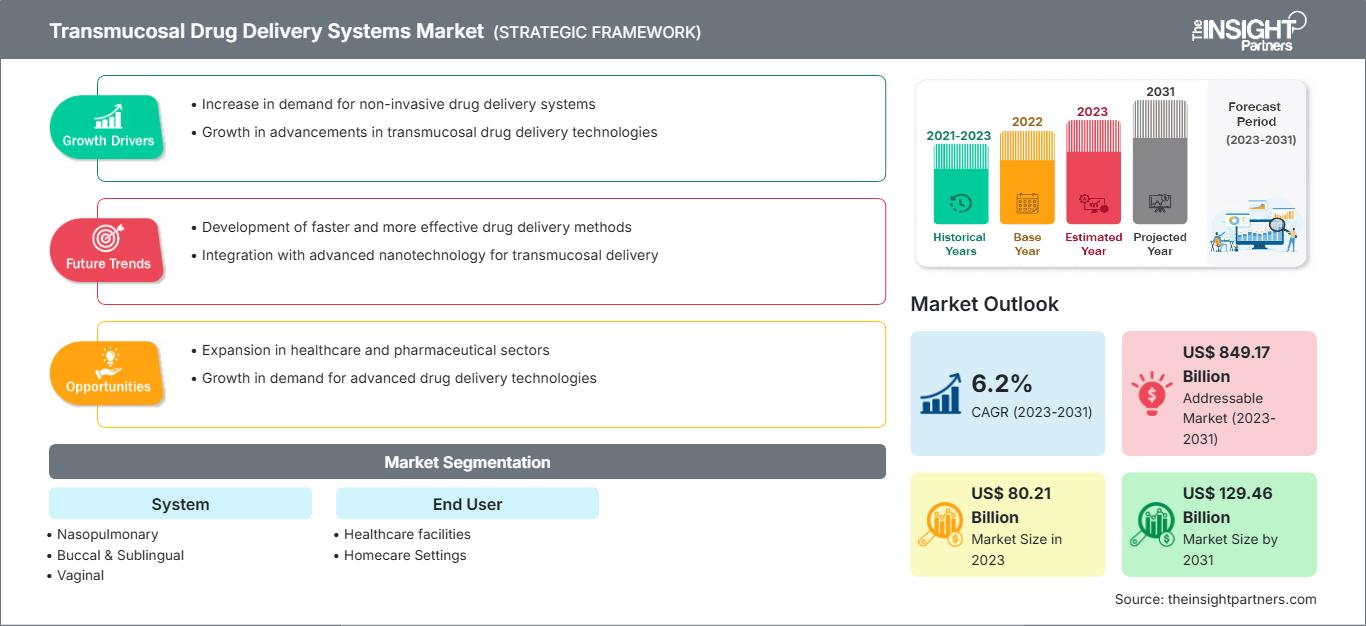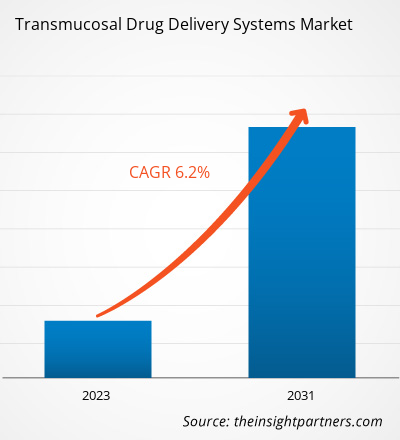[Forschungsbericht] Der Markt für transmukosale Arzneimittelverabreichungssysteme soll von 80,21 Milliarden US-Dollar im Jahr 2023 auf 129,46 Milliarden US-Dollar im Jahr 2031 wachsen; von 2023 bis 2031 wird eine durchschnittliche jährliche Wachstumsrate (CAGR) von 6,2 % erwartet.
Analystenmeinung
Bei der transmukosalen Arzneimittelverabreichung werden Schleimhäute wie die Mundschleimhaut, die Nasenschleimhaut, die Rektalschleimhaut, die Vaginalschleimhaut, die Augenschleimhaut und die Lungenschleimhaut zur Arzneimittelverabreichung genutzt. Höhere Bioverfügbarkeit, schneller Wirkungseintritt, Umgehung des First-Pass-Metabolismus und einfache Verabreichung sind die Hauptvorteile dieses Arzneimittelverabreichungssystems gegenüber herkömmlichen Verabreichungswegen. Der Bericht enthält Wachstumsaussichten aufgrund der aktuellen Markttrends für transmukosale Arzneimittelverabreichungssysteme und ihrer vorhersehbaren Auswirkungen im Prognosezeitraum.
Faktoren, die das Marktwachstum transmukosaler Arzneimittelverabreichungssysteme vorantreiben
Die transmukosale Arzneimittelverabreichung ist aufgrund ihrer anhaltenden Wirksamkeit eine bevorzugte Verabreichungsmethode. Transmukosale Verabreichungswege wie intranasal, bukkal, sublingual und rektal sind nicht-invasive Methoden der systemischen Verabreichung von Medikamenten. Sie sind besonders nützlich, da Pflegepersonal oder Patienten diese Medikamente ohne Fachpersonal verabreichen können. Darüber hinaus sind sie aufgrund des schnellen Wirkungseintritts mit reduziertem First-Pass-Metabolismus ideal für die Palliativ- und Sterbebegleitung. Sie wirken schnell, lindern die Symptome und bieten den Patienten rasche Linderung. Infolgedessen erfreuen sich transmukosale Verabreichungssysteme bei der Behandlung verschiedener chronischer Krankheiten wie Herz-Kreislauf-Erkrankungen, Diabetes und chronischen Atemwegserkrankungen großer Beliebtheit. Einem im Januar 2020 in PubMed Central veröffentlichten Artikel zufolge wurde eine Studie zur Untersuchung und zum Vergleich der Sicherheit und Pharmakokinetik von Dihydroergotamin (DHE) bei Verabreichung in Form von intranasalem DHE-Pulver (STS101), intranasalem DHE-Spray (Migranal) und intramuskulärer (IM) DHE-Injektion an gesunde Probanden durchgeführt. Die Studie kam zu dem Schluss, dass STS101 eine leicht zu verabreichende, nicht injizierbare Akutbehandlung von Migräne mit einem günstigen Verträglichkeitsprofil ist. Darüber hinaus wird erwartet, dass es eine schnelle und anhaltende Schmerzlinderung ermöglicht und Migränesymptome ohne Rückfall unterdrückt.
Zahlreiche pharmakologische Arzneimittel werden als orale transmukosale Darreichungsformen angeboten; dazu gehören Herz-Kreislauf-Mittel, Sedativa und Analgetika. Biologisch abbaubare orale Filme unterstützen die Medikamentenverabreichung in den systemischen Kreislauf, was besonders für Personen mit Dysphagie, wiederholtem Erbrechen, Bluthochdruck, Herzinfarkt, Asthma, Übelkeit, Lähmungen und psychischen Störungen von Vorteil ist. Diese schnell auflösenden oralen Filme sind dünne Klebestreifen, die auf die Zunge oder die Mundschleimhaut des Patienten geklebt werden.
Vorteile wie einfache Verabreichung, hohe Bioverfügbarkeit, systemische Medikamentenverfügbarkeit und schnelle Wirkung beflügeln daher das Marktwachstum transmukosaler Arzneimittelverabreichungssysteme.
Passen Sie diesen Bericht Ihren Anforderungen an
Sie erhalten kostenlos Anpassungen an jedem Bericht, einschließlich Teilen dieses Berichts oder einer Analyse auf Länderebene, eines Excel-Datenpakets sowie tolle Angebote und Rabatte für Start-ups und Universitäten.
Markt für transmukosale Arzneimittelabgabesysteme: Strategische Einblicke

-
Holen Sie sich die wichtigsten Markttrends aus diesem Bericht.Dieses KOSTENLOSE Beispiel umfasst Datenanalysen, die von Markttrends bis hin zu Schätzungen und Prognosen reichen.
Berichtssegmentierung und -umfang
Die „Globale Marktanalyse für transmukosale Arzneimittelabgabesysteme bis 2031“ ist eine spezialisierte und gründliche Studie der Pharmaindustrie mit besonderem Fokus auf der Analyse globaler Markttrends. Der Bericht soll einen Überblick über den Markt mit detaillierter Marktsegmentierung nach Systemen, Endbenutzern und Geografie bieten. Er liefert wichtige Statistiken zu den führenden Marktteilnehmern und erwähnt wichtige Trends und Chancen, die auf dem Markt vorherrschen. Der Umfang des globalen Marktberichts für transmukosale Arzneimittelabgabesysteme umfasst Nordamerika (USA, Kanada und Mexiko), Europa (Deutschland, Frankreich, Italien, Großbritannien, Spanien und übriges Europa), den asiatisch-pazifischen Raum (China, Japan, Indien, Australien, Südkorea und übriger asiatisch-pazifischer Raum), den Nahen Osten und Afrika (Südafrika, Saudi-Arabien, Vereinigte Arabische Emirate und übriger Naher Osten und Afrika) sowie Süd- und Südamerika. Mittelamerika (Brasilien, Argentinien und Rest von Süd- und Mittelamerika).
Systembasierte Erkenntnisse
Basierend auf den Systemen ist der Markt in nasopulmonale, bukkale und sublinguale, vaginale und sonstige Systeme unterteilt. Das nasopulmonale Segment hatte 2023 den größten Marktanteil bei transmukosalen Arzneimittelverabreichungssystemen und wird voraussichtlich von 2023 bis 2031 die höchste durchschnittliche jährliche Wachstumsrate (CAGR) verzeichnen.
Endnutzerbasierte Erkenntnisse
Basierend auf dem Endnutzer ist der Markt in Gesundheitseinrichtungen, häusliche Pflege und sonstige Systeme unterteilt. Das Segment Gesundheitseinrichtungen hatte 2023 den größten Marktanteil. Dies ist auf die Verfügbarkeit besserer Einrichtungen und qualifizierter Ärzte in Krankenhäusern zurückzuführen. Darüber hinaus wird erwartet, dass das Segment der häuslichen Pflege von 2023 bis 2031 die höchste durchschnittliche jährliche Wachstumsrate (CAGR) aufweist.
Regionale Analyse
Geographisch ist der Markt hauptsächlich in Nordamerika, Asien-Pazifik, Europa, den Nahen Osten und Afrika sowie Süd- und Mittelamerika unterteilt. Gemessen am Umsatz hatte Nordamerika im Jahr 2023 den größten Marktanteil bei transmukosalen Arzneimittelverabreichungssystemen. Die USA dominieren den Markt in dieser Region. Dies ist auf die zunehmende Zahl chronischer Erkrankungen wie Diabetes, Asthma und Herzerkrankungen sowie die wachsende Zahl von Produkteinführungen wichtiger Akteure zurückzuführen.
Transmukosale Arzneimittelverabreichungssysteme
Regionale Einblicke in den Markt für transmukosale ArzneimittelabgabesystemeDie Analysten von The Insight Partners haben die regionalen Trends und Faktoren, die den Markt für transmukosale Arzneimittelverabreichungssysteme im Prognosezeitraum beeinflussen, ausführlich erläutert. In diesem Abschnitt werden auch die Marktsegmente und die geografische Lage transmukosaler Arzneimittelverabreichungssysteme in Nordamerika, Europa, im asiatisch-pazifischen Raum, im Nahen Osten und Afrika sowie in Süd- und Mittelamerika erörtert.
Umfang des Marktberichts zu transmukosalen Arzneimittelabgabesystemen
| Berichtsattribut | Einzelheiten |
|---|---|
| Marktgröße in 2023 | US$ 80.21 Billion |
| Marktgröße nach 2031 | US$ 129.46 Billion |
| Globale CAGR (2023 - 2031) | 6.2% |
| Historische Daten | 2021-2023 |
| Prognosezeitraum | 2023-2031 |
| Abgedeckte Segmente |
By System
|
| Abgedeckte Regionen und Länder |
Nordamerika
|
| Marktführer und wichtige Unternehmensprofile |
|
Dichte der Marktteilnehmer für transmukosale Arzneimittelverabreichungssysteme: Verständnis ihrer Auswirkungen auf die Geschäftsdynamik
Der Markt für transmukosale Arzneimittelverabreichungssysteme wächst rasant. Dies wird durch die steigende Endverbrauchernachfrage aufgrund veränderter Verbraucherpräferenzen, technologischer Fortschritte und eines stärkeren Bewusstseins für die Produktvorteile vorangetrieben. Mit der steigenden Nachfrage erweitern Unternehmen ihr Angebot, entwickeln Innovationen, um den Bedürfnissen der Verbraucher gerecht zu werden, und nutzen neue Trends, was das Marktwachstum weiter ankurbelt.

- Holen Sie sich die Markt für transmukosale Arzneimittelabgabesysteme Übersicht der wichtigsten Akteure
Branchenentwicklungen und zukünftige Chancen:
Die Marktprognose für transmukosale Arzneimittelabgabesysteme kann den Beteiligten in diesem Markt bei der Planung ihrer Wachstumsstrategien helfen. Laut Pressemitteilungen des Unternehmens sind nachfolgend einige strategische Entwicklungen führender Akteure auf dem Weltmarkt aufgeführt:
- Im Februar 2024 präsentierte Aquestive Therapeutics, Inc. auf der Jahrestagung 2024 der American Academy of Allergy, Asthma, and Immunology (AAAAI) in Washington, DC, ein Poster, das die positiven pharmakokinetischen (PK) und pharmakodynamischen (PD) Daten aus zwei vollständigen klinischen Studien zu sublingualem Anaphylm (Epinephrin)-Film hervorhob.
- Im August 2022 startete iX Biopharma Ltd IXB-322, ein neues Programm zur Erweiterung seiner Pipeline. Das Programm zielt darauf ab, einen sublingualen Dexmedetomidin-Wafer zur Behandlung von Unruhe bei Demenz und anderen Indikationen zu entwickeln. Diese Initiative ist Teil der Strategie von iX Biopharma, bestehende zugelassene Medikamente mithilfe der firmeneigenen WaferiX-Technologie für die Arzneimittelverabreichungsplattform umzuwidmen.
- Im Mai 2021 hat die Tillotts Pharma AG, ein Teil der japanischen Zeria Group, mit der Einführung von AsacolTM 1g (Mesalazin) ihr Gastroenterologie-Portfolio um ein neues Medikament erweitert. Das hochwirksame Zäpfchen wird zur Behandlung von leichten bis mittelschweren Symptomen einer ulzerativen Proktitis bei Erwachsenen verwendet. Diese Markteinführung wird dem Unternehmen helfen, Patienten mit Magen-Darm-Erkrankungen innovative Therapien anzubieten. AsacolTM 1g-Zäpfchen bieten eine bequeme Behandlungsform für Personen, die an ulzerativer Proktitis leiden, da sie nur eine einzige Tagesdosis benötigen.
- Im April 2021 gab Teva Pharmaceuticals USA, Inc., eine US-amerikanische Tochtergesellschaft von Teva Pharmaceutical Industries Ltd., die Veröffentlichung einer generischen Version des Zäpfchenmedikaments Casana 1 (Mesalamin) bekannt. Das Medikament ist in den USA zur Behandlung der aktiven ulzerativen Proktitis (rektale Colitis ulcerosa) zugelassen.
Teva Pharmaceutical Industries Ltd; Cigna Corporation.; BioDelivery Sciences International, Inc; 3M; Henkel Finland Oy; GlaxoSmithKline plc; Aquestive Therapeutics, Inc; Camurus AB; Ximedica; und Noven Pharmaceuticals, Inc sind einige der wichtigsten Unternehmen, die im Marktbericht für transmukosale Arzneimittelverabreichungssysteme vorgestellt werden. Diese führenden Akteure konzentrieren sich auf die Ausweitung und Diversifizierung ihrer Marktpräsenz und ihres Kundenstamms und nutzen Geschäftsmöglichkeiten auf dem Markt.
- Historische Analyse (2 Jahre), Basisjahr, Prognose (7 Jahre) mit CAGR
- PEST- und SWOT-Analyse
- Marktgröße Wert/Volumen – Global, Regional, Land
- Branchen- und Wettbewerbslandschaft
- Excel-Datensatz
Aktuelle Berichte
Verwandte Berichte
Erfahrungsberichte
Grund zum Kauf
- Fundierte Entscheidungsfindung
- Marktdynamik verstehen
- Wettbewerbsanalyse
- Kundeneinblicke
- Marktprognosen
- Risikominimierung
- Strategische Planung
- Investitionsbegründung
- Identifizierung neuer Märkte
- Verbesserung von Marketingstrategien
- Steigerung der Betriebseffizienz
- Anpassung an regulatorische Trends






















 Kostenlose Probe anfordern für - Markt für transmukosale Arzneimittelabgabesysteme
Kostenlose Probe anfordern für - Markt für transmukosale Arzneimittelabgabesysteme